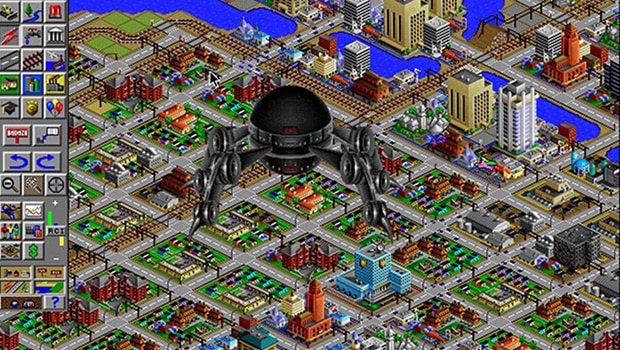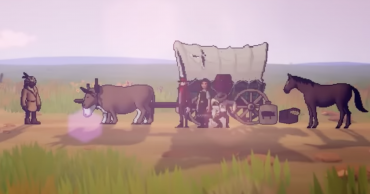
To understand how the SimCity Franchise changed video games forever, we first need to take a trip back to the early days of the PC. For many readers this will be humorous, while for others it will be nostalgic. It will require us to look both at the hardware and software limitations of the time, limitations that compared to today’s most basic computer configurations seem like people in the late 1980’s were working with clay tablets and stone styluses. Yet from this rudimentary technology came a video PC game that remains one of the most popular among PC gamers.
The original version of SimCity was released in 1989. Windows version 3.1 was not yet introduced into the mainstream computer market, an event that would follow three years later. The basic computer configuration was an 80286 Intel processor, 2 megabytes of RAM, a 60 megabyte hard disk, a single 3.5 inch floppy with a 720,000 byte storage capacity (or a 5.25 inch floppy disk with 1.2 megabytes of storage), and a 12 or 15 inch VGA monitor. This configuration would cost you about $1,000 depending on brand, model, etc.
This is what Maxis, the company that was the creator and developer of the original SimCity, had to work with. (Although technically the game had been developed for the Commodore 64 five years earlier, it had even greater limitations than these PCs.) Even though Windows 3.0 was technically a graphical user interface, it was not much more than a tiny step up from the DOS operating system environments that many users of the day refused to give up until Windows 3.1 changed the hearts of many PC users. The early version of the game featured block graphics and gameplay involved using the arrow keys (not many computer users dared to venture into the world of the tethered mouse yet) to choose your areas of development. It did have the essential residential, commercial, and industrial zoning areas but animation was very limited.
What was a game changer in 1989 was Maxis developing what amounted to a real world simulation on a computer, a simulation that would be the basis of all later versions of the SimCity Franchise. This concept of simulating real world events based on the data stored in a database is what is basically imitated in most of today’s most popular games. The online game databases of today are stored on remote servers accessed through the Internet. The solo player games that can be played on a standalone computer require huge amounts of disk space, far more than was available in 1989.
Rather than having a random set of events occurring with the player having no real control of the outcome, or a table of results that would define the predictability of a game’s outcome, the growth of an area was based on historical data and proven methods of city planning that were more in line with reality. This eliminated two important features of the vast majority of PC games that were currently on the market — predictability and frustration (with randomness).
One of the unexpected positive outcomes of the SimCity was it gave players the belief that they actually had control over the game, and by following a certain series of steps the result would be virtually guaranteed. But this was an extremely complex series of correct decision making and largely excluded the possibility of predictability. Many people suddenly turned their real life career paths towards city planning, in part because they were so successful at playing SimCity. While computer/video games would be the target of many of society’s ills for a number of years, SimCity was never the target of such accusations. However, as a former player I can personally testify to its addictive nature. The first time I started playing SimCity I was up all night — then headed to work the next morning — and I’m not the only one.
Another unexpected benefit from the creation of SimCity was the creation and publishing of books on gaming. The subject of many of the SimCity books was city planning, and within the program of SimCity was a list of books on city planning that was intended to educate the player and help them get better. There were also books written on the best ways to play the game and reach your desired SimCity goals. Today there are cheats, hacks, and online communities telling all about how to win a game, but back then almost all information you got about computers came from a book. Online manuals are the norm, though many first time players opt to learn from trial and error — until they make too many errors.
The idea for SimCity came from its creator Will Wright who was inspired by a game that used maps to navigate game play. This basic concept of mapping is present in most modern games since everything from Wolfenstein to Call of Duty has mapping inherent in the movement and intrigue factor of the game. If you are someone who is more intrigued by the creation of maps and mods than the actual game play, you are a brother-in-creativity with Will Wright because he was exactly the same way.
Now you would think that if you brought a game with so many unique features to a PC game manufacturer in the late 1980’s they would jump at the opportunity. But history is not so kind to SimCity as almost every company except one, (Maxis) would turn down the idea of the game. Looking back, this is a really weird decision because there weren’t many quality PC games around. Many of the PC owners were business people because the idea of every home having a computer was more of a vision than a possibility. Those that owned them for personal use were more intrigued by their potential than their actual use.
But the underlying reason for SimCity being rejected was the fact that it could neither be won nor lost. This concept was unheard of in 1989 since the point of playing any game, even a board game, was that there was a winner and losers. SimCity let the player advance to different levels and play at different strengths, concepts that are so ingrained into today’s games that the absence of these basic features would result in either unbridled outrage or a complete boycott of the company. Think about playing a game against the computer, only because in 1989 the Internet was nowhere close to being a thing. Just using your landline telephone connection to connect to remote networks such as AOL or Compuserve for too many hours could send your phone bill flying into the $200 to $400 a month range.
If it seems this strange and unique journey of a concept had come to an end once it landed in the hands of Maxis, you would be wrong. In fact, the next “evolution” of SimCity would add to its list of ways it changed the video game world forever. SimCity was popular, playable, and profitable for Maxis and in 1993 an updated version would be released — SimCity 2000. Gone were the block graphics which resulted in layers that could reveal water pipes and subways. There was no actual 3D view but the shapes of the terrain was now isometric, using those once challenging triangular graphic shapes to build on. This new version would closely parallel the release of the aforementioned Windows 3.1, which opened the window for a new and more robust features for game play.
With the improved graphics capabilities of Windows 3.1 the floodgates opened for Maxis and the SimCity Franchise to make significant improvements to its game. For one thing, there were futuristic concepts integrated into the game, including fusion power plants and microwave receivers as power sources for the city. Some people may argue whether these are actual mods as we know them today, but it is certain they are within the realm of normal game play and definitely bring a different dimension to the game. Here, futuristic needs to be distinguished from fantastical, as the two power plants mentioned above were very much realistic concepts in 1993. It would be another four years until the microwave oven would become a common household product.
Before we move on to the last version of the SimCity Franchise that would have a significant impact on the future of video games, there is at least one notable feature that is worthy of mention. When the original SimCity was released, the PC speaker was actually only a speaker in name. You couldn’t play music through it or much of anything else for that matter. There were sound cards you could purchase, but so few games competently handled game sounds that it was a low priority for most people. But when SimCity 2000 came out they added music to play by. Today, a game with no sound is not considered to be a game at all. For many people this was one of the best features of game play as it was meditative in nature. After SimCity 3000 it was replaced by something other than the original calming sounds.
SimCity 3000 was the last release of the franchise to make a significant impact on the future of video games. What SimCity 2000 started to do with some features, SimCity closed the deal on. The last two iterations of the franchise gave players more control of the decision making processes by increasing the granularity of the user controls. For example, in the 2000 version the player could change the tax rates for individual taxes rather than have a single tax for the entire city. Intended to give more flexibility to the player on raising income, SimCity 3000 expanded on the income idea by allowing a city to connect to a neighboring city and sell it water, power, etc. Today, the Madden Football Franchise follows a similar pattern as do many other popular games.
In general, SimCity 3000 increased the realism of the game, particularly as it applied to the actual intended outcome of creating a city from the ground up. The added granularity of both the graphics and the gameplay had the intended effect of creating a more addictive game and made buying the next version well worth the money. The long term impact of the SimCity Franchise can be summed up like this:
- Maximizing the use of the hardware configuration to create a better user experience
- Meeting the demand of users for an increased user satisfaction experience by consistently improving the graphics
- Introducing the concepts of mapping and real world data to produce realistic outcomes
- Making proficiency at a game more important than winning the game
- Creating gameplay that is truly addictive
EA Sports would buy Maxis and move away from the foundational concepts that made SimCity one of the most popular games on the planet. The focus shifted to personalities and away from city planning, undermining what was once an educational and inspirational game that captured the attention of millions.
As the 30th anniversary of the original PC version of the SimCity Franchise approaches, it is hard to come up with a game that has changed the video game industry significantly and for such a long period of time. There are games such as Dungeons and Dragons that have captivated players for decades. There are games that have survived the PC and made their way on to the various gaming console platforms. But underneath the vast majority, if not all, of those games are the basic concepts of mapping to determine the parameters of the gameplay and a solid injection of realism, historical or otherwise. These features have immensely improved the quality of video games for all players, young and old.
 Follow Us
Follow Us





